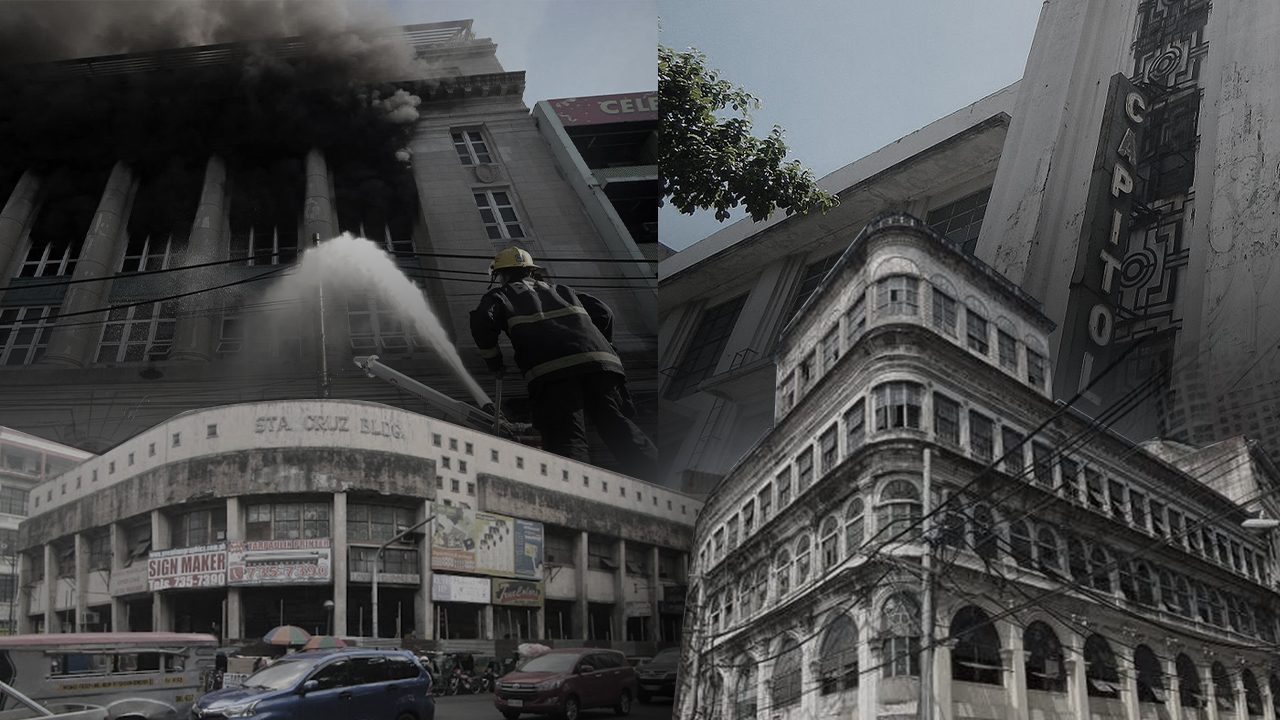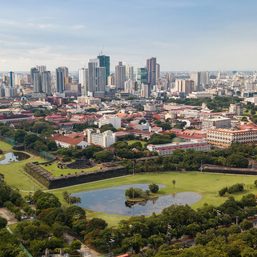SUMMARY
This is AI generated summarization, which may have errors. For context, always refer to the full article.

MANILA, Philippines – Late Sunday night, May 21, a devastating fire engulfed the renowned Manila Post Office in Manila. The historic building, recognized as a national historical landmark, was severely damaged, prompting a General Alarm response that involved the mobilization of 80 fire trucks to combat the blaze.
After approximately eight hours of relentless efforts, authorities finally declared the fire under control at 7:22 am.
The fire-razed Post Office functions as the central hub for the Philippine Postal Corporation, overseeing the essential tasks of mail sorting and distribution throughout the country.
Unfortunately, Manila has witnessed several occasions in recent years where its treasured heritage sites have fallen victim to fires, demolition, or faced the looming threat of demolition.
Juan Luna Building
In 2018, a fire broke out in the Juan Luna Building, a nearly century-old structure that housed the National Archives of the Philippines. The fire originated from the nearby Land Management Bureau in the early hours past midnight and quickly spread to the Juan Luna building by 8 am.
The fire primarily damaged the fourth and fifth floors of the building. Additionally, the Plaza Cervantes building and Moraga Mansion were also affected by the blaze. Despite the fire impacting the National Archives office, the agency reassured the public that no historical documents were lost, as they were securely stored in their offices located in Paco and Ermita.
The structures are at Plaza Cervantes in Binondo, Manila, where a number of pre-war buildings stand.
Old Sta. Cruz Building
The Sta. Cruz Building, constructed in 1948, once served as a prominent landmark in Escolta, attracting visitors who sought both luxurious and affordable timepieces in the commercial district of Manila.
Efforts by heritage conservation advocates have been ongoing to protect the heritage building, which had been been at the brink of demolition amid various challenges in recent years.
In 2019, the deserted building was devastated by a fire, further intensifying the challenges faced in its preservation.
Eventually, the post-war structure met its demise in August 2021 following a seismic event that shook Manila in July. The National Historical Commission of the Philippines (NHCP), concerned about public safety due to the building’s weak foundations, authorized its demolition.
However, the NHCP also mandated the developer, who plans to construct a condominium on the site, to replicate the entire facade and arcade of the original building, preserving its historical significance.
Capitol Theater
Designed by National Artist Juan Nakpil in 1935, this Art Deco building near the corner of Yuchengco Street and Escolta gained prominence as the home of the Capitol Theater during Escolta’s golden era. With its double balcony setup, the theater could accommodate approximately 1,100 patrons and was renowned as “Manila’s Most Modern Theater” and “The Showplace of the Nation.”
The Capitol Theater was distinguished by its impeccable geometric form, both on its facade and in its interior, which embraced the theme of the Sampaguita, the national flower of the Philippines.
However, despite its historical significance, the theater was demolished in June 2020, following persistent rumors of its impending destruction.
The National Commission for Culture and the Arts, the National Historical Commission of the Philippines, and the National Museum granted permission to the developer to carry out the demolition. However, they stipulated that the theater’s tower and facade must be preserved, acknowledging their architectural and cultural value.
El Hogar Filipino Building
The El Hogar Filipino Building, situated at the junction of Juan Luna Street and Muelle dela Industria, was designed by Spanish-Filipino engineer Ramon Irureta-Goyena and architect Francisco Perez-Muñoz in 1914. This iconic skyscraper showcases a fusion of architectural styles, including Beaux-Arts, Neoclassical, and Renaissance influences.
Originally, the building was a wedding gift from Spanish businessman Don Antonio Melian y Pavia, Conde de Peracamps, to his wife Doña Margarita Zobel y de Ayala. It served as the office space for Sociedad El Hogar Filipino, a lending cooperative, as well as Ayala y Compania, now known as Ayala Corporation.
In 2014, concerns arose when reports emerged that El Hogar tenants were being asked to vacate the premises, sparking speculation about its potential demolition.
Subsequently, three years later, the Manila local government reportedly endorsed the demolition. As of now, the El Hogar building stands vacant, awaiting its fate. – Rappler.com
Add a comment
How does this make you feel?
![[Uncle Bob] No whores at the Oarhouse](https://www.rappler.com/tachyon/2024/06/oarhouse-june-28-2024-2.jpg?resize=257%2C257&crop=414px%2C0px%2C1080px%2C1080px)










![[OPINION] From ‘Puyat’ to ‘Tulog’: Clout-chasing street signs disrespected history](https://www.rappler.com/tachyon/2024/07/gil-puyat-july-26-2024.jpg?resize=257%2C257&crop=389px%2C0px%2C1080px%2C1080px)


![[Time Trowel] Yamashita gold is a myth, and treasure hunting is not archeology](https://www.rappler.com/tachyon/2024/06/myth-yamashita-treasure-june-14-2024.jpg?resize=257%2C257&crop=435px%2C0px%2C1080px%2C1080px)
There are no comments yet. Add your comment to start the conversation.